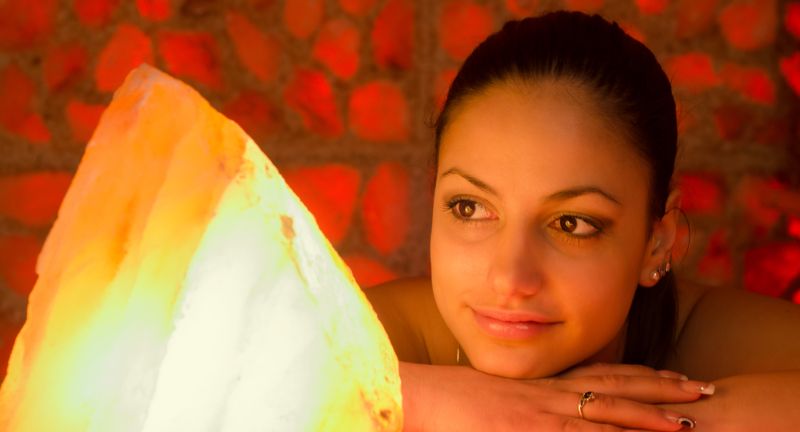WELLNESS
Do Himalayan Salt Lamps Really Work? 18 Things to Consider
Published
2 weeks agoon

Shutterstock
Himalayan salt lamps have become a popular home décor item, admired for their warm glow and potential wellness benefits. Many people believe they can help purify the air, reduce stress, and create a calming atmosphere. However, with so many claims surrounding these unique lamps, it’s important to separate fact from fiction. While they certainly add a cozy ambiance to any space, their true benefits go beyond aesthetics. Here’s everything you need to know before buying a Himalayan salt lamp, from its origins to maintenance tips.
They Are Made from Real Himalayan Salt

Shutterstock
Authentic Himalayan salt lamps are carved from pink salt crystals mined in the Khewra Salt Mine in Pakistan, which is one of the oldest and largest salt mines in the world. These salt deposits are over 250 million years old and contain trace minerals that give them their unique color. Each lamp is carefully handcrafted, making every piece one-of-a-kind with its own natural texture and variations. Due to the rarity and quality of the salt, genuine Himalayan salt lamps are often considered a premium home décor item.
Their Distinctive Pink Hue Comes from Minerals

Shutterstock
Himalayan salt lamps come in various shades of pink, orange, and red due to the presence of trace minerals within the salt. These minerals include iron, potassium, magnesium, and calcium, which contribute to the lamp’s warm and inviting glow. No two lamps are exactly alike, as the color intensity depends on the mineral concentration in each salt block. The richer and darker the color, the higher the mineral content, making some lamps more desirable than others.
They Are Said to Release Negative Ions

Shutterstock
Many Himalayan salt lamp enthusiasts believe these lamps release negative ions into the air, which may help purify and refresh indoor spaces. Negative ions are naturally produced by waterfalls, thunderstorms, and ocean waves, and are said to counteract positive ions that come from electronic devices. While some claim these lamps create a similar effect, scientific studies have not provided strong evidence to support this idea. However, many users report feeling more relaxed and at ease in rooms illuminated by salt lamps.
They Absorb Moisture from the Air

Shutterstock
Himalayan salt lamps are naturally hygroscopic, meaning they attract and absorb moisture from the air. If you live in a humid climate, you may notice that your lamp appears damp or even “sweaty.” This is a natural reaction and can be minimized by keeping the lamp on, which allows the heat from the bulb to evaporate the collected moisture. If excessive moisture builds up, simply wipe the lamp with a dry cloth to prevent salt erosion.
They Can Support Relaxation and Sleep

Shutterstock
Many people find the warm, amber glow of Himalayan salt lamps soothing and conducive to relaxation. The gentle light is less harsh than artificial lighting and can create a peaceful ambiance, making it ideal for bedrooms and meditation spaces. Some believe that the lamp’s presence helps regulate melatonin production, promoting better sleep. While scientific studies on this effect are limited, the soft, natural lighting can certainly contribute to a cozy nighttime routine.
They May Help Reduce Allergens and Dust

Shutterstock
Due to their ability to absorb moisture from the air, Himalayan salt lamps may also help capture airborne particles like dust, pollen, and pet dander. By drawing in moisture, these lamps can potentially reduce allergens floating in the air. While not a substitute for an air purifier, they might provide some relief for individuals with mild allergies. However, for best results, the lamp should be used in conjunction with other air-cleaning methods.
They Can Be Fragile

Shutterstock
Himalayan salt lamps are delicate and prone to chipping or cracking if dropped or handled roughly. The salt is naturally soft compared to other rock materials, making it more susceptible to damage. It’s best to place your lamp in a secure location where it won’t be easily knocked over. If a small chip does occur, it won’t affect the lamp’s functionality, but larger cracks may require replacing the lamp.
Not All Salt Lamps Are Authentic

Shutterstock
With the popularity of Himalayan salt lamps, many fake versions have flooded the market. Some are made from dyed rock salt or even plastic, making them less effective and aesthetically inferior. A genuine salt lamp will have a slightly rough, uneven surface and emit a soft, warm glow rather than an intense bright light. If a lamp is extremely cheap or looks too perfect, it may not be authentic.
They Come in Various Shapes and Sizes

Shutterstock
Himalayan salt lamps are available in different shapes, sizes, and designs to fit various aesthetic preferences. Some lamps retain their natural rugged shape, while others are carved into smooth spheres, pyramids, or even novelty figures like hearts and animals. The larger the lamp, the more surface area it has to interact with the air, which some believe enhances its potential benefits. Choosing a lamp is a matter of personal preference, but the authenticity of the salt is what truly matters.
They Need Regular Maintenance

Shutterstock
To keep your Himalayan salt lamp in good condition, it requires occasional maintenance. Since the lamp absorbs moisture, wiping it down with a dry or slightly damp cloth can help prevent excess buildup. Keeping the lamp turned on for several hours a day can also help evaporate moisture and reduce the chances of it “weeping.” If the lamp starts shedding too much salt, it may be exposed to excessive humidity and should be moved to a drier location.
They Can Be a Fire Hazard If Poorly Made

Shutterstock
While Himalayan salt lamps themselves are not inherently dangerous, some models have been recalled due to faulty electrical components. Poorly made lamps with substandard wiring or unstable bases can pose a fire risk. To ensure safety, always purchase lamps from reputable manufacturers and check that they meet electrical safety standards. Using LED bulbs instead of incandescent bulbs can also reduce heat and minimize fire hazards.
They Might Help With Seasonal Affective Disorder (SAD)

Shutterstock
While not a medical treatment, the warm glow of a Himalayan salt lamp can create a cozy and comforting ambiance during dark winter months. Some people with Seasonal Affective Disorder (SAD) find that soft, warm lighting helps improve their mood. Though these lamps do not replace light therapy devices, they can contribute to a soothing atmosphere that promotes relaxation. Their calming effect makes them a popular addition to homes during colder seasons.
Pets May Be Attracted to the Salt

Shutterstock
Cats and dogs are sometimes drawn to licking Himalayan salt lamps, which can be dangerous for their health. Excessive salt consumption can lead to sodium poisoning in pets, causing symptoms like vomiting, diarrhea, and seizures. If you have pets, place your salt lamp in a location where they cannot access it. If you notice your pet showing interest in the lamp, it’s best to keep it out of their reach entirely.
They Are Not a Cure-All

Shutterstock
Despite marketing claims, Himalayan salt lamps are not scientifically proven to cure respiratory issues, allergies, or other medical conditions. While they may help create a more relaxing atmosphere, they should not be relied upon as a primary health solution. Many people enjoy them for their aesthetic and ambiance rather than expecting major health benefits. If you’re looking for air purification, a HEPA filter is a more effective option.
They Work Best in Smaller Spaces

Shutterstock
To experience any potential benefits of a Himalayan salt lamp, it is best used in small to medium-sized rooms. A single small lamp in a large space may not have any noticeable effect on air quality or ambiance. If you want to cover a larger area, multiple lamps might be needed. However, even a small lamp can add warmth and charm to a cozy corner or bedside table.
They Have a Unique, Soothing Glow

Shutterstock
The warm amber-pink light emitted by Himalayan salt lamps creates a calming and peaceful atmosphere. Unlike bright white LED lights, their gentle glow is softer on the eyes and promotes relaxation. This makes them an excellent choice for nighttime lighting, helping to reduce exposure to harsh blue light from screens. Many people use them in living rooms, bedrooms, and meditation spaces for their cozy ambiance.
They Can Be Used in Feng Shui

Shutterstock
In Feng Shui, Himalayan salt lamps are believed to clear negative energy and promote balance in a space. Their warm light is thought to create a sense of harmony and relaxation, making them a popular addition to homes and workplaces. Some practitioners place salt lamps in specific areas to encourage positive energy flow and emotional well-being. Whether or not you believe in Feng Shui principles, these lamps can contribute to a peaceful and inviting environment.
They Make Thoughtful Gifts

Shutterstock
With their unique beauty and calming glow, Himalayan salt lamps make a great gift for friends and loved ones. They are a thoughtful present for those who appreciate home décor, relaxation, and wellness. Because each lamp is unique, it adds a personal touch to any space. Whether for a birthday, holiday, or housewarming, a salt lamp is a stylish and meaningful choice.
Conclusion

Shutterstock
Himalayan salt lamps are more than just a trendy home accessory—they bring a warm, inviting glow that enhances any space. While their health benefits may not be scientifically proven, many people enjoy their calming ambiance and aesthetic appeal. Whether you’re drawn to them for their unique look, potential air-purifying qualities, or simply as a relaxing addition to your décor, they can be a wonderful addition to your home. Like any decorative item, they require care and maintenance to ensure longevity and performance. Ultimately, whether you believe in their wellness claims or just love the cozy atmosphere they create, Himalayan salt lamps remain a beautiful and soothing element in any space.
Related Topics:

More From Lifestylogy
-


25 Ways To Incorporate More Potassium Into Your Diet
-


How To Be Productive After Christmas
-


30 Essential Vitamins and Minerals Your Body Needs
-


Why Skipping Cardio Should Never Be An Option
-


22 Exercises That Make The Most Impact In Your Workout…
-


The Secret to Getting Ready Right: Start Your Day with…
-


31 Reasons Why Headphones Are Bad For You
-


Rise and Shine: 27 Mindful Morning Habits to Supercharge Your…
-


29 of the Strangest Fears That People Actually Have